This post may contain affiliate links. Please read our disclosure policy.
Pork Katsu (or Tonkatsu) is one of my favorite Japanese dishes – the pork cutlet is coated in panko breadcrumbs (the secret to this dish!) and fried to perfection! My recipe turns out super crispy on the outside, and so delicious and juicy on the inside every time with a few key tips and proper technique, all of which I cover in this recipe. Pair it with homemade Tonkatsu Sauce and you have yourself a mouth-watering delicious meal!

Watch the Pork Katsu Recipe Video Below!
Table of Contents
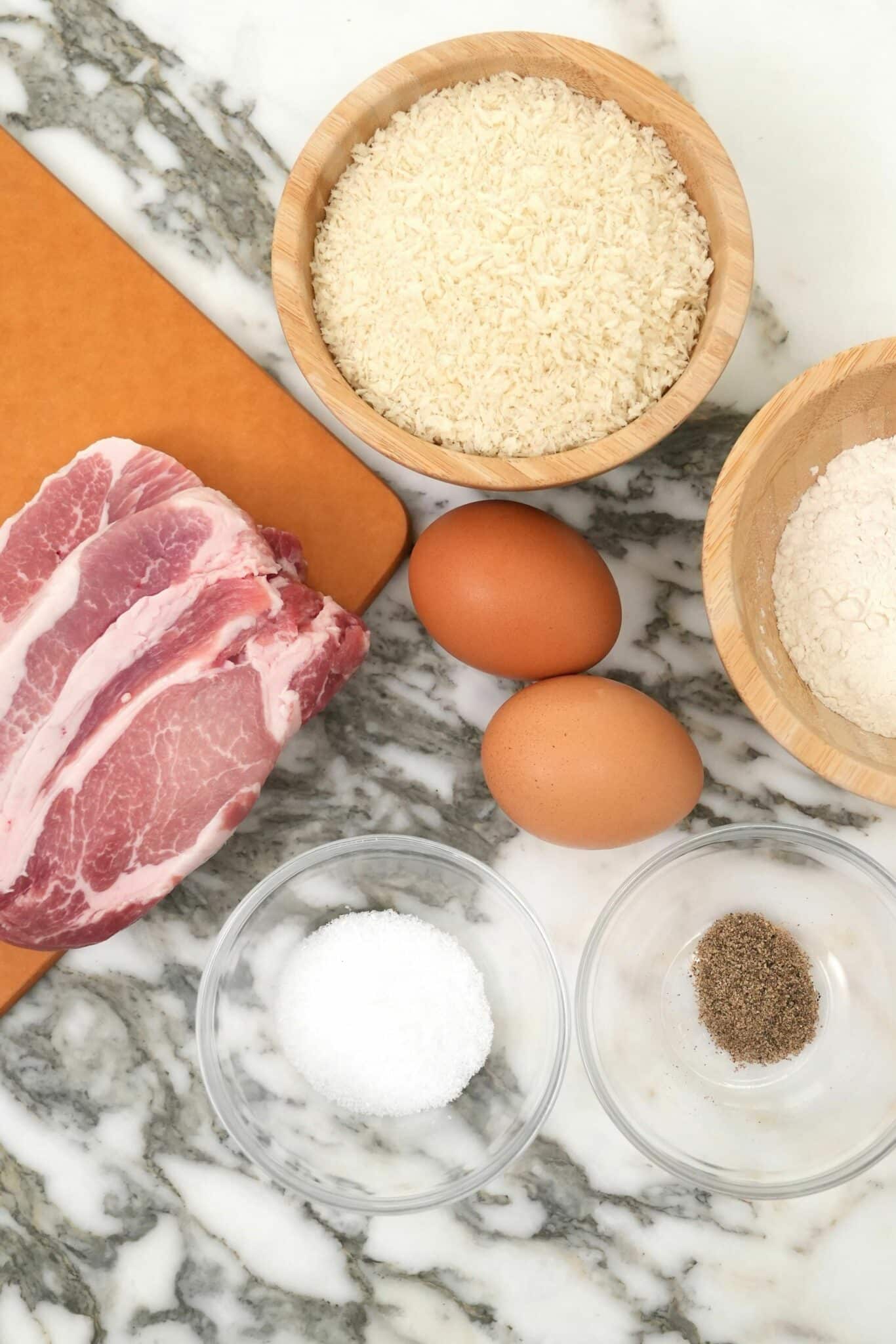
Key Tip
What Kind of Pork Should I Use for Pork Katsu (or Tonkatsu)?
You will need pork loin filets, preferably from the center pork loin. As this recipe is extremely simple, with only a handful of ingredients, I highly recommend using the highest quality pork you can find. The pork loin has more fat, or marbling, which in my opinion results in a tastier end product. If you prefer a leaner cut of pork, opt for a pork tenderloin when making Tonkatsu
If the pork cutlets you buy are thicker than 1/2″, you will want to pound the pork cutlets to 1/2″ thickness, as even thickness as possible – this will ensure that your pork will cook evenly!
I use a meat mallet to pound my meat but you can use any blunt, heavy object you have in your kitchen (like a small cast iron skillet, a rolling pin, heavy cans, even a soup ladle could work).
Ingredient Tips
Pork Katsu only requires 6 ingredients – making it the perfect easy meal to throw together!
- pork loin filets – pounded to 1/2″ thickness; see above for notes.
- If you prefer to use chicken, make Chicken Katsu instead! If you’re not in the mood for frying, you can use your air fryer to make Air Fryer Chicken Katsu.
- eggs, large
- all-purpose flour
- salt
- black pepper
- panko breadcrumbs – this is a key ingredient and I cannot recommend any substitutions.
- Panko breadcrumbs are made from a special type of white bread that is baked without a crust. The bread is sliced into large, thin slices and dried out; the dried bread is then ground into coarse flakes that are larger and lighter than traditional breadcrumbs.
- This is why the best Pork Katsu is breaded in panko breadcrumbs – the lighter panko breadcrumbs allow for a crispier, lighter crunch than traditional breading (like for fried chicken).
Tonkatsu Sauce
It’s not Pork Katsu (or Tonkatsu) without homemade Tonkatsu Sauce! Many people like to eat Pork Katsu with Bulldog Sauce but I personally prefer making my own sauces, as I can control which ingredients go in and customize it exactly to my liking!
Optional – Serve With
- thinly sliced cabbage
- rice
- if you love Hawaii as much I do, try serving this with Hawaiian Mac Salad just like the beloved Hawaiian plate lunches!
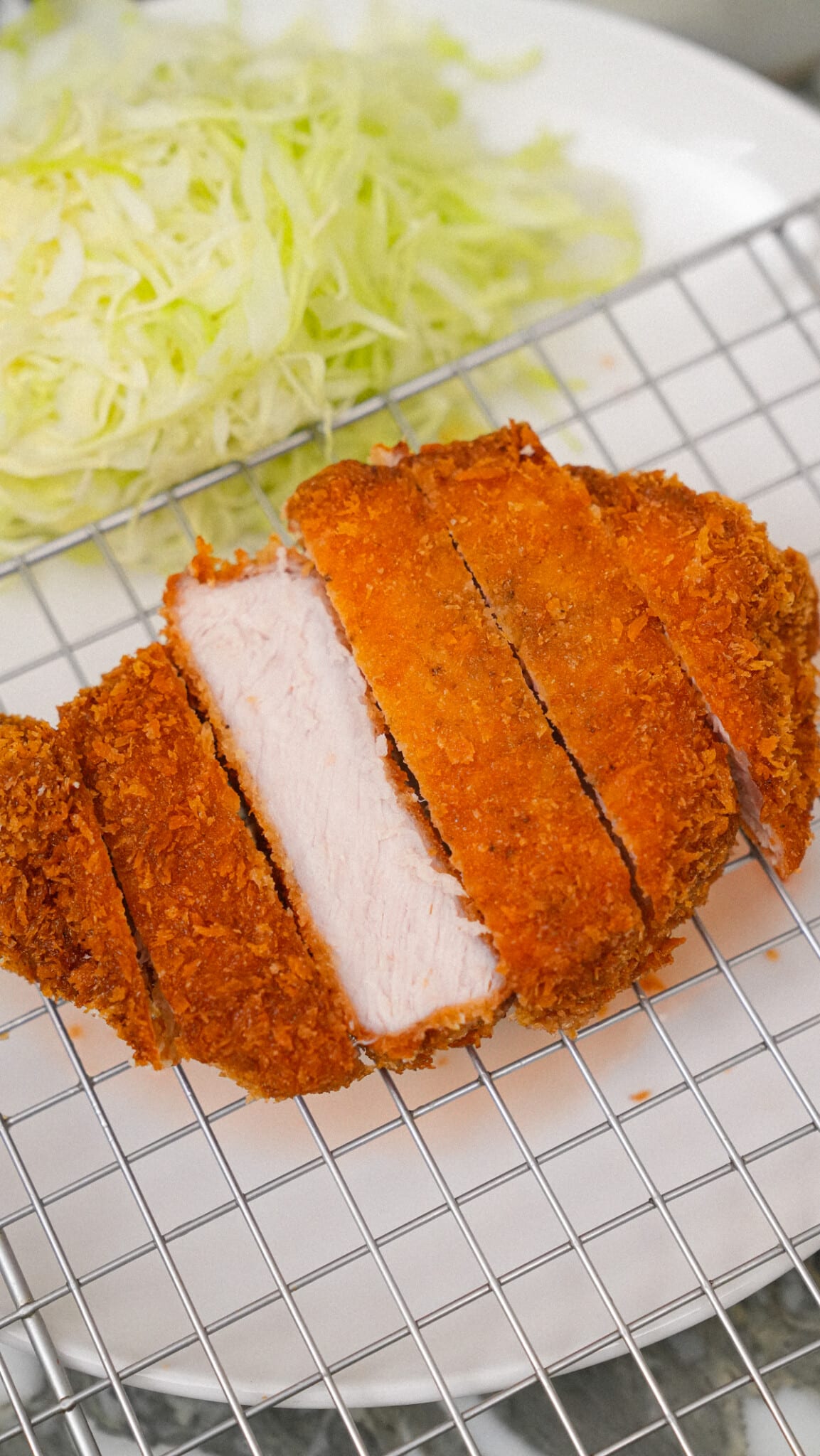
Recipe Instructions for Pork Katsu
1. Prepare and Season the Pork Cutlets
Using a meat mallet or heavy pan, pound pork loin to 1/2″ thick cutlets. The more even your pork cutlets are, the more evenly they will cook – so do not skip this step! If the cutlets are already at 1/2″ thickness, check for a fat cap along the edge of the pork. If there is a thick cap, take a knife and make small slits along the fat cap. This will ensure the pork loin remains flat when frying, rather than curling up.
This is optional but I like to use the back of a knife to pound against the pork to tenderize it.
Season both sides with salt and pepper and bring to room temperature.
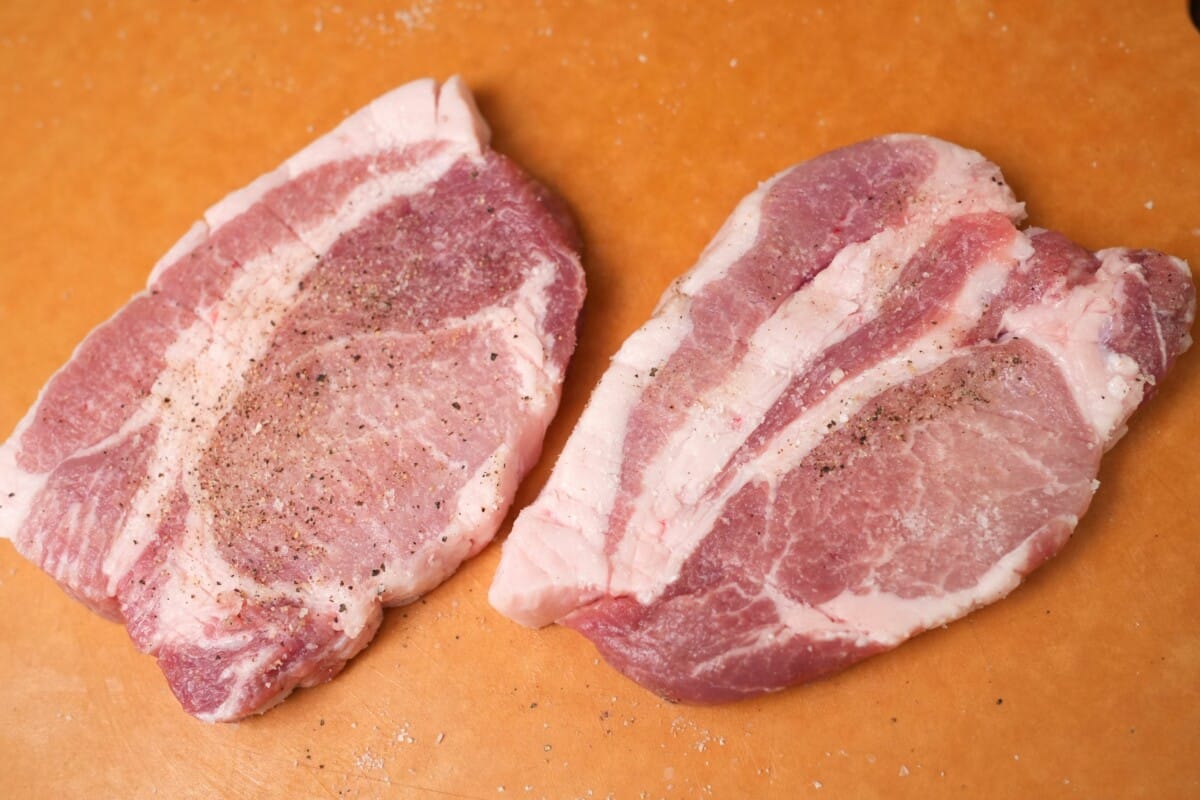
2. Assemble the Dredging Stations
Crack the eggs into a large bowl big enough to fit the pork. Ensure the yolk and whites are mixed very well, otherwise the egg mixture won’t cover the meat evenly and will lead to the batter falling off.
Beat thoroughly until combined. Place the flour in another bowl or tray that is large enough to fit the pork. This process is assembly line style, so you want to have both the flour, egg and panko breadcrumbs ready to go.
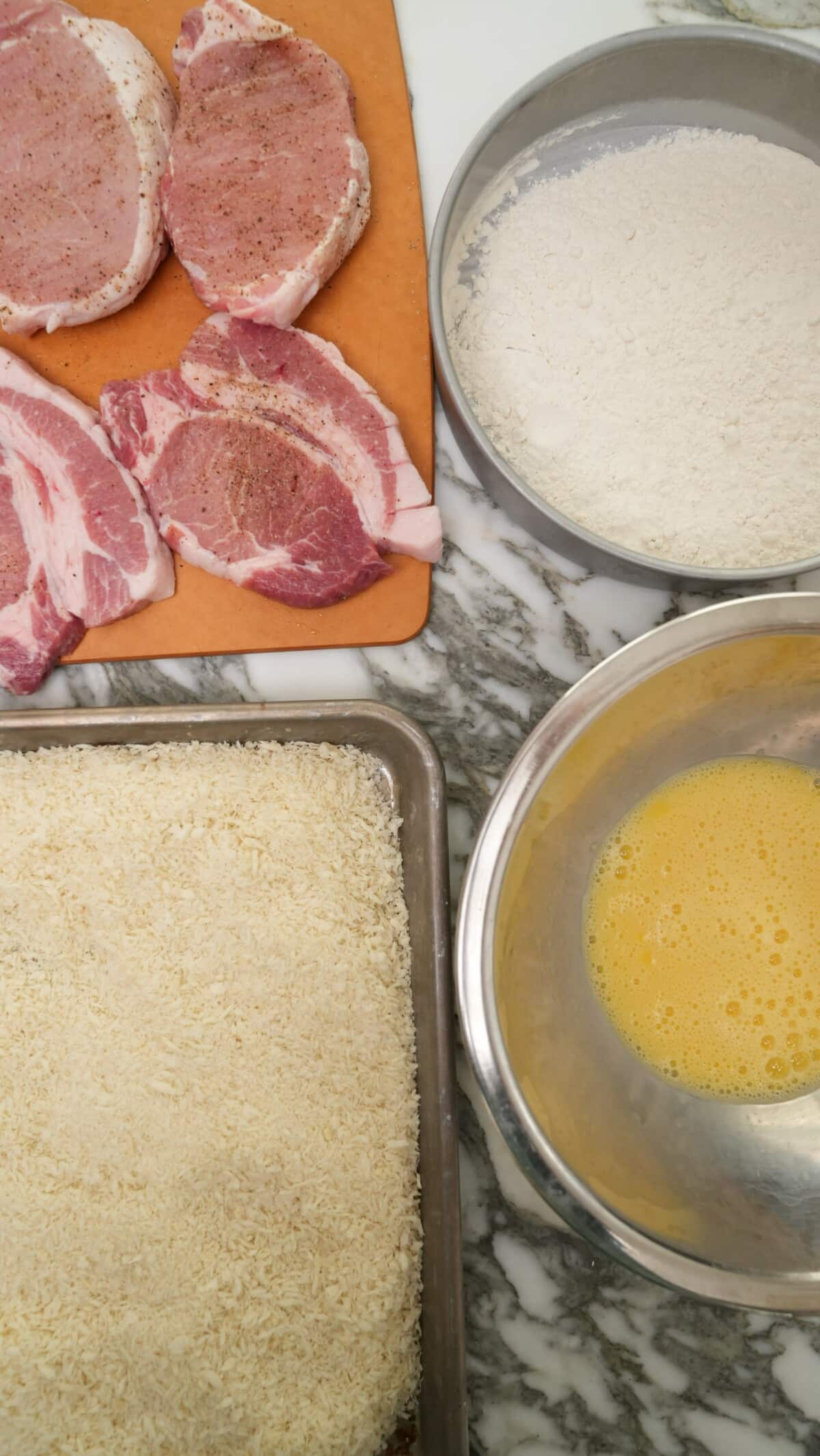
3. Dredge the Pork
Dredging the pork cutlets will be a two-step process – first, a dusting of flour followed by an egg wash and then panko breadcrumbs.
- In a flat bowl or plate, place the all-purpose flour and ensure the area is large enough to fully coat the pork. Place the pork in the flour and cover completely. Shake off any excess flour.
- In a second flat bowl or plate, beat the eggs until thoroughly combined.
- Take each pork cutlet and dredge in the egg, letting any excess egg drip off.
- Immediately transfer the pork cutlet into the bowl or plate with panko breadcrumbs. Coat thoroughly in panko breadcrumbs – pack it in so there are no bald spots! Packing it in ensures that when you fry the cutlets, every bite of your Pork Katsu will be crispy from the panko breadcrumbs!
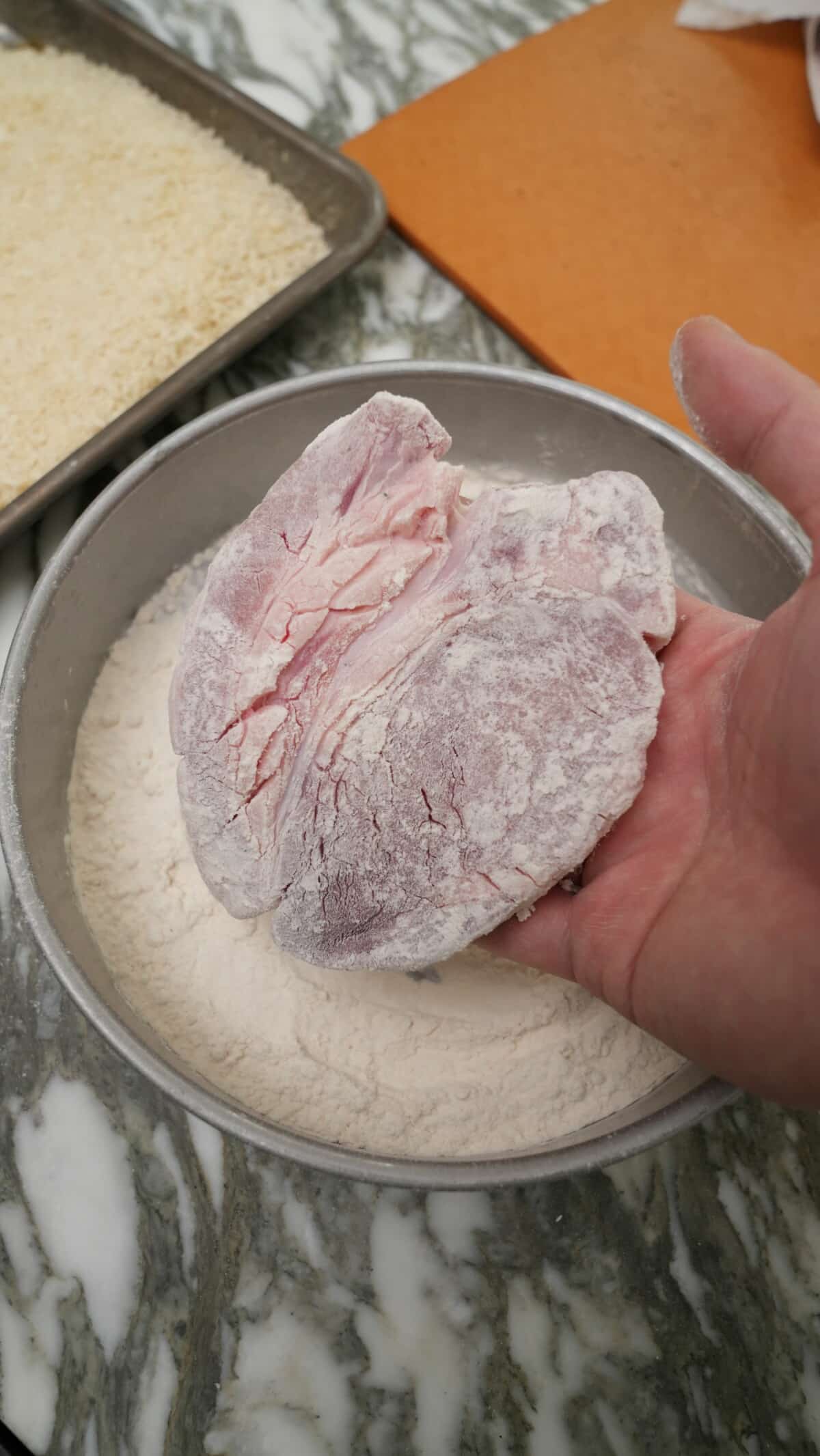
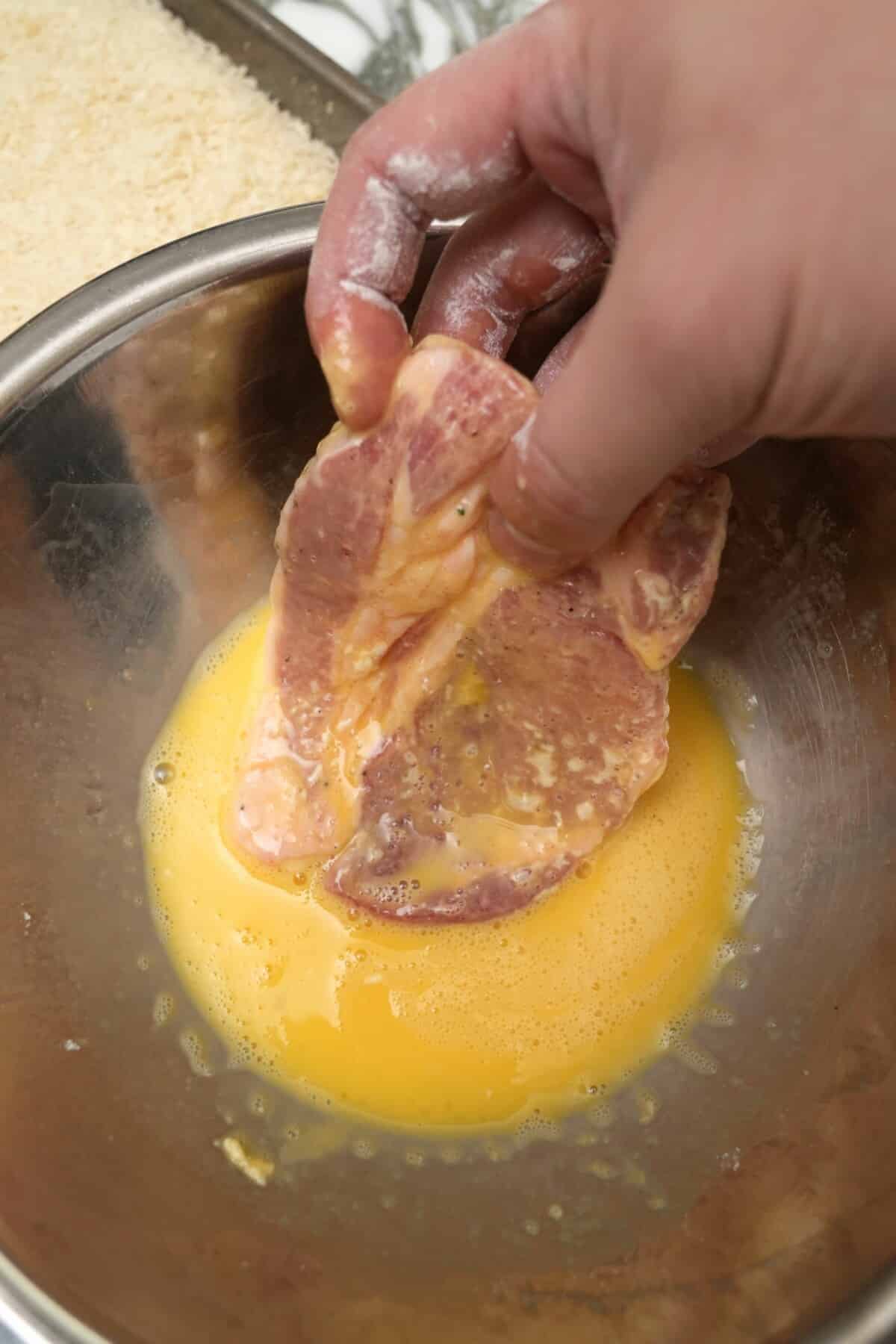

4. Fry the Pork Katsu
In a heavy bottomed dutch oven (or large pot), heat oil to 350°F. Fry each pork cutlet for 4-5 minutes or until the pork reaches 145F (this the recommended internal temperature for pork). Use a thermometer to monitor your oil temperature and do not over-crowd your dutch oven or pot!
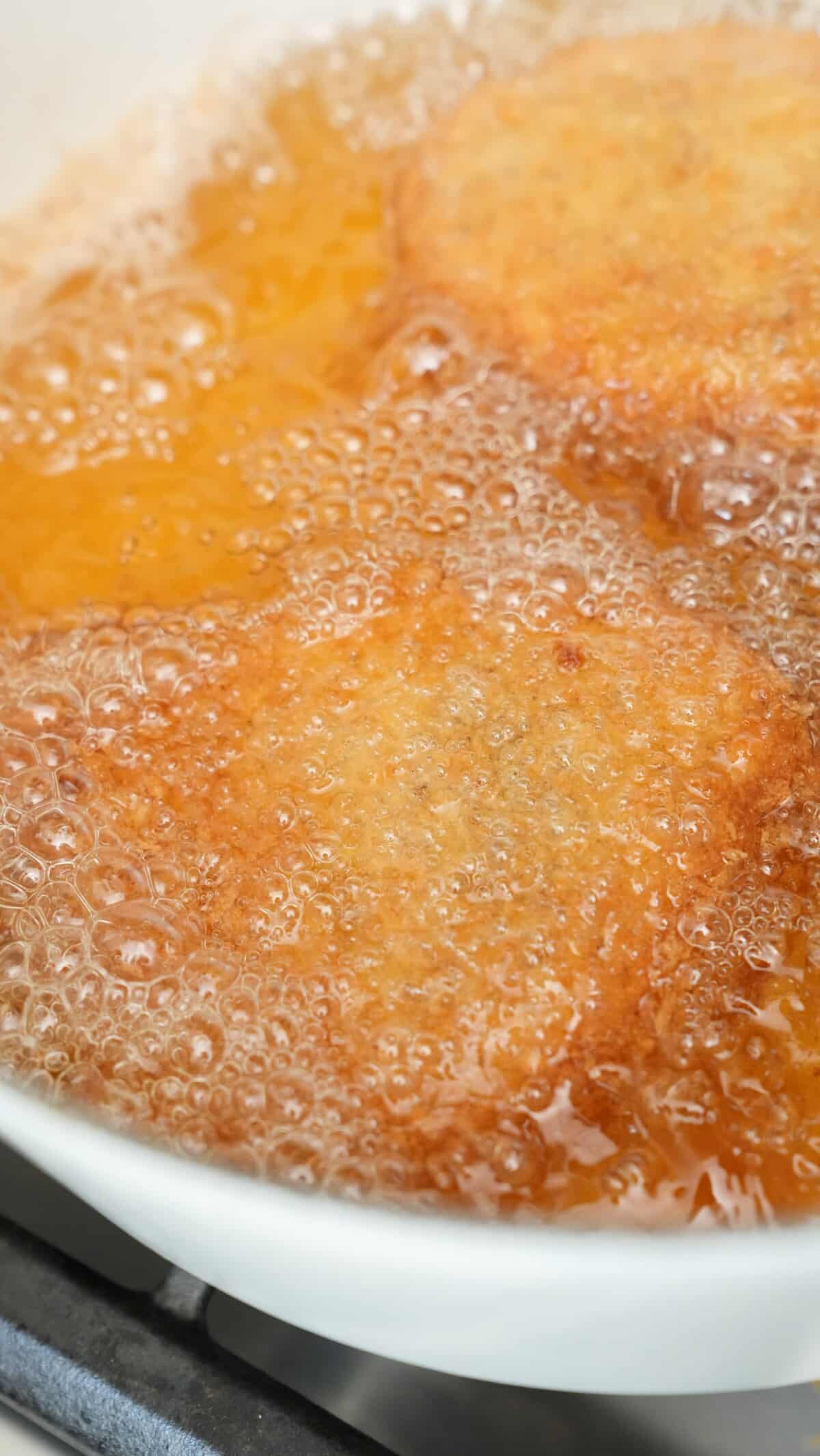
Once fried, remove the Pork Katsu and place on paper toweled lined plates or a rack for any excess oil to drip off and for the Pork Katsu to cool before serving. I like to slice my Pork Katsu into even strips but you can serve it whole, too!
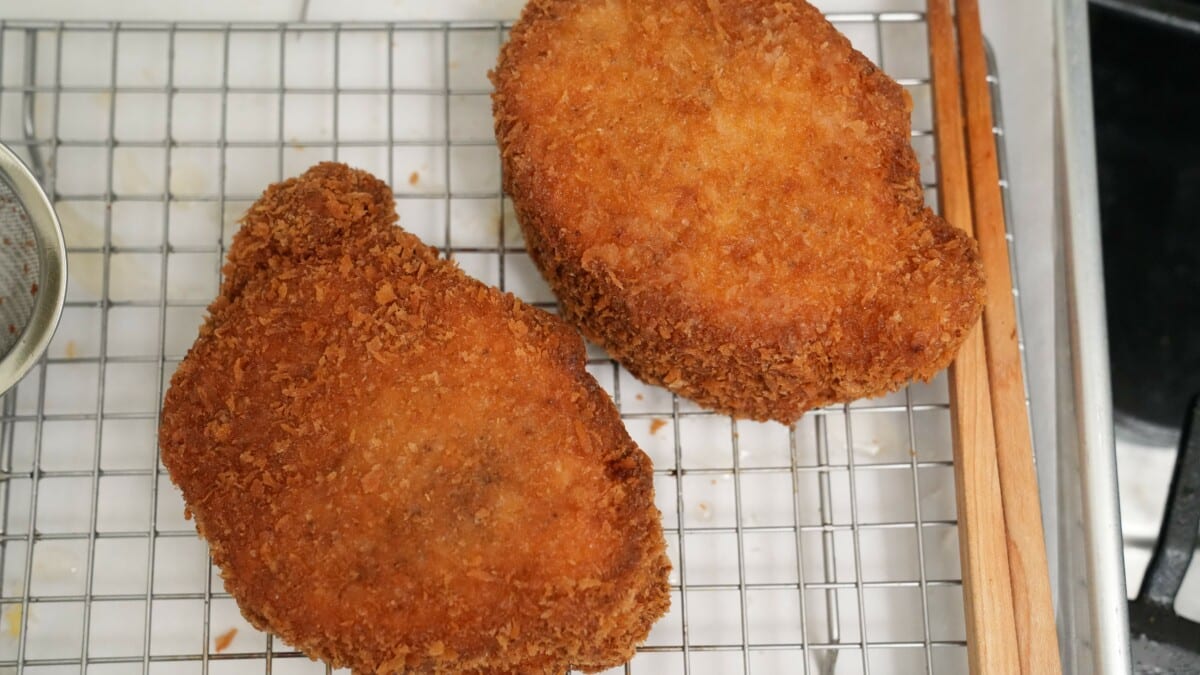
My Pro Tip
Expert Tips for Pork Katsu
Pound the Pork
If the pork you buy is too thick, you’ll need to pound your pork to 1/2″ thick cutlets – if you don’t have a meat mallet, you can use a small pan, rolling pin, or even a heavy can! Try to keep these as even as possible – the more evenly they’re pounded, the more evenly your Pork Katsu will fry!
Fry at the Right Temperature
Fry the Pork Katsu (or Tonkatsu) in oil that has been heated to 350°F (180°C) for the best results. This will ensure that the Pork Katsu cooks quickly and evenly without becoming too oily.
- If you are frying multiple pieces at one time, you may notice that your oil temperature is lower than 350°F (180°C) . If your temperature drops to below 325°F (160°C), it means you are overcrowding and frying too many Pork Katsu pieces at one time. Take a couple pieces out in order to allow the oil to come back to temperature.
- If your oil is too high, reduce your heat and wait for the temperature to come down before continuing frying your Pork Katsu.
- If you are frying large batches of Tonkatsu, use a fine mesh strainer to pick up any loose breading that has fallen into the oil. Doing this in between frying will prevent the breading from burning and turning your oil bitter.
Pork Internal Temperature
I highly recommend you use a meat thermometer to check your Pork Katsu after frying – pork needs to reach an internal temperature of 145F to be safe to eat. Undercooked meat can lead to food poisoning, so always err on the side of caution!
Optional Sides
I like to serve Pork Katsu with sliced cabbage, rice, and homemade Tonkatsu Sauce!
Homemade Tonkatsu Sauce
You can easily purchase Pork Katsu (or Tonkatsu) sauce from most grocery stores (many people like the Bulldog brand) – but if you want to make your own, I included the recipe below! I like to make my own sauces as often as possible, as it’s usually easy enough and store versions oftentimes have fillers & preservatives.
Storage and Reheating
You can store any leftover Pork Katsu (or Tonkatsu) (already cooked) in an air tight container for up to 3 days in the refrigerator.
To reheat the Pork Katsu (or Tonkatsu), I prefer the air fryer – reheat the pork for 8-10 minutes at 350°F or in the oven at 400° for 15 minutes. The exterior should be crispy while keeping the inside juicy!
Cooking with Pork
I love cooking with pork because it has so much great flavor and has less of a risk of drying out, making it a perfect protein for cooks of all skill levels! Some of my most popular recipes on my blog are with pork –
- My Yeh-Yeh’s Crispy Pork Belly is not only delicious but extremely special to me (and I’m so proud of my Air Fryer Crispy Pork Belly recipe, which gets similar results but in just one hour!)
- my Sticky Asian Ribs are super addictive and perfect for a gathering!
- you can’t forget about the Chinese takeout classic, Sweet and Sour Pork!
- Red Braised Pork is the perfect easy meal – you simply throw together the ingredients and let the braising do all of the magic!
If you tried this Pork Katsu Recipe or any other recipe on my website, please leave a 🌟 star rating and let me know how it went in the comments below!
Pork Katsu (Tonkatsu) – SUPER CRISPY!
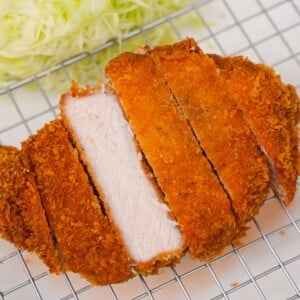
Equipment
Ingredients
Pork
- 4 pork loin filets, 1/2" thick cutlets
- 2 large eggs
- 1/4 cup all-purpose flour
- 1/2 tsp salt
- 1/2 tsp black pepper
- 2 cups panko breadcrumbs
Serve With
- thinly sliced cabbage
- rice
- tonkatsu sauce
Instructions
- Using the a knife, make small slits along the fat cap and pound against the pork with the sharp side of the knife to tenderize each filet. Season both sides with salt and pepper.
- Crack the eggs into a large bowl big enough to fit the pork. Beat thoroughly until combined. Place the flour in another bowl or tray that is large enough to fit the pork.
- Dredge chicken in flour and shake off any excess. Dip the pork in the egg and let the excess egg drip off, then coat thoroughly in panko breadcrumbs.
- Heat oil to 350F and fry for 4-5 minutes or until the pork reaches 145F.
- Serve with fried pork cutlets with sliced cabbage, rice, and tonkatsu sauce.
Notes
Storage and Reheating
You can store any leftover Pork Katsu (or Tonkatsu) (already cooked) in an air tight container for up to 3 days in the refrigerator. To reheat the Pork Katsu (or Tonkatsu), I prefer the air fryer – reheat the pork for 8-10 minutes at 350°F or in the oven at 400° for 15 minutes. The exterior should be crispy while keeping the inside juicy!Nutrition
Nutrition information is automatically calculated, so should only be used as an approximation.

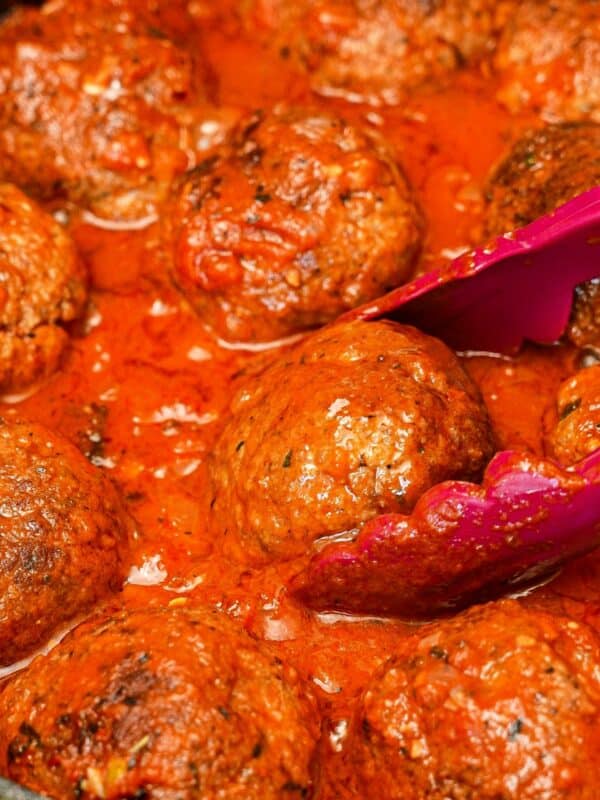

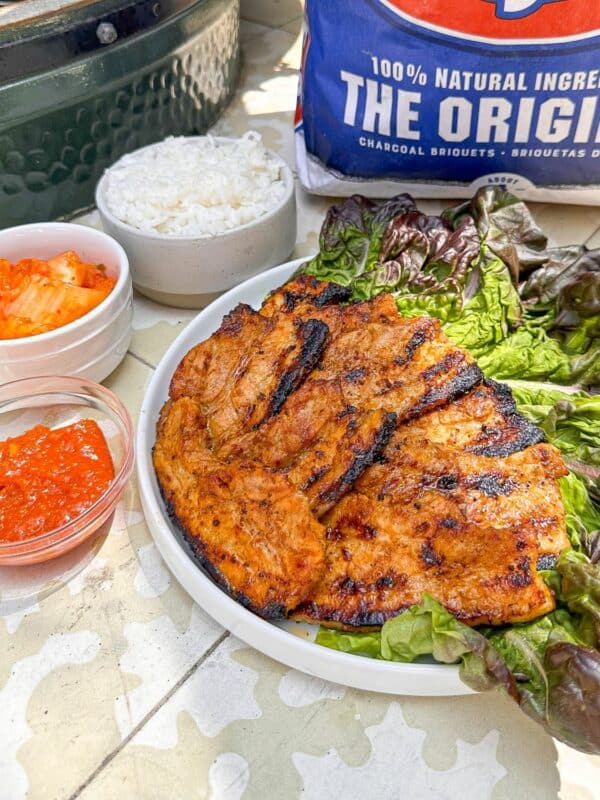
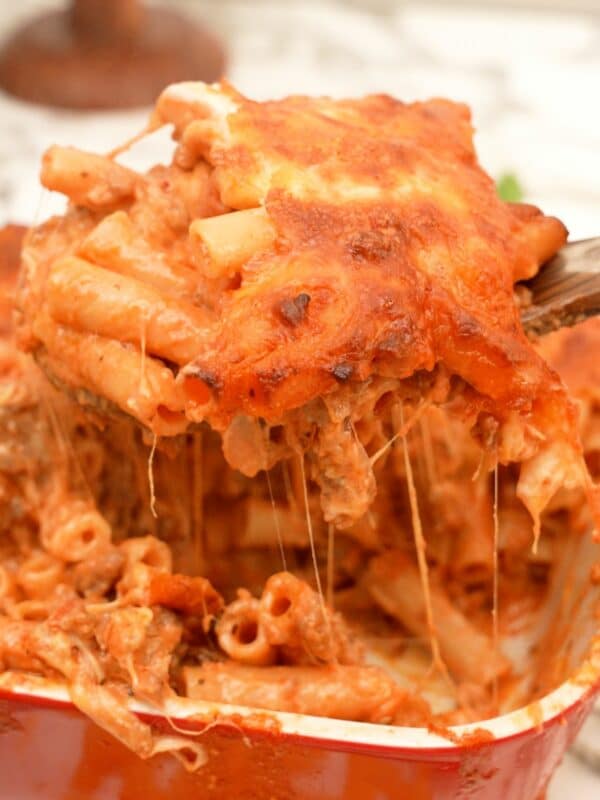







Love your recipes and this tonkatsu recipe is simple, easy to follow, and most of all delicious. My mom taught me how to lay panko out on a cookie sheet and lightly mist with a spray bottle. This causes the panko to expand which gives you a larger crumb. Can’t wait to make this again!
Reiko – thanks so much for the kind words! I love your mom’s tip and will definitely have to try that next time!
Made this pork katsu for dinner and it was a big hit with the family. It came out very crispy and tender. Also made the Hawaiian mac salad along with the katsu sauce.
Thanks, Chong! I appreciate the kind words!
Delicious! Thanks! Your tip worked! Frying at the right temp cooked quickly and evenly!!
I’m so glad you enjoyed it!
Two thumbs up
AMAZING! So delish!! Just another great dish from CJ!
Used this recipe but baked instead of fried. Still tasted great!
We LOVE this Katsu recipe. Adding the flour to the eggs is genius. It’s perfect and crispy every time. I have even had to let the pork rest breaded for an hour or so and it never gets soggy it stays crunchy and crispy. It’s a week-night staple in our house.
So glad you and your family are enjoying, Noell!